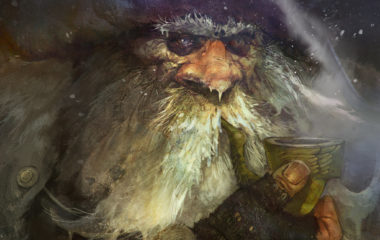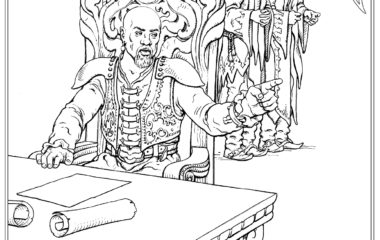Urû’baen was the capital of Galbatorix’s Empire. Originally called Ilirea, it was founded by the elves when they first arrived in Alagaësia, and then abandoned after it was partially destroyed during the Dragon War. The Fair Folk allowed the Broddring men to claim and rebuild Ilirea as their capital after the cessation of conflict between King Palancar and the elves. Once humans were added to the Dragon Rider pact, members—including Oromis and Glaedr—resided and trained in the city.

Very early in Ilirea’s history (prior to the events of the Inheritance Cycle), the elves discovered a fissure beneath Ilirea that released vapors that:
“…increased the chances that those who slept near it might catch a glimpse, if however confused, of future events. So, over two and a half thousand years ago, the elves built this room atop the fissure, and an oracle came to live here for many hundreds of years, even after the elves abandoned the rest of Ilirea.”(Galbatorix, Inheritance Deluxe, page 421)
“…she whiled away the centuries dreaming of all that had been and all that might be. In time, the air lost its potency and the oracle and her attendants departed. Who she was and where she went, none can say for sure.” (Galbatorix, Inheritance Deluxe, page 421)
Years passed until Galbatorix, newly graduated, convinced Morzan to leave the gate to Ilirea open, thereby allowing him to steal a dragon hatchling to replace Jarnunvösk, who had died in a skirmish with the Urgals. Morzan and Galbatorix disappeared together for some time, hiding in evil places while they practiced dark magics. Their goals were initially hidden in a shroud of rumors, but the two eventually found twelve others willing to betray their order.
Oromis and Glaedr found out about Galbatorix’s treachery and rushed back to Ilirea to warn the Riders of the impending attack. To the elder dragon and elf’s dismay, few of their number remained stationed in the city; most had left to investigate rumors of dissent or consult with Vrael, the Rider’s leader, on Vroengard. Shortly thereafter, Galbatorix and the Thirteen Forsworn destroyed the majority of their former allies and many of their holdings, including the island headquarters. There were too few forces to defend Ilirea and it was captured. The Dragon Riders were resoundingly defeated.
Galbatorix killed the Broddring king, Angrenost, and crowned himself monarch, consolidating his captured territories into the Empire. He renamed Ilirea to Urû’baen and took residence in the royal citadel. The new king erected countless enchantments around the city and its people; he also added extra fortification and thickened the width and height of the walls to bolster Urû’baen’s defenses.
Around one hundred years later, the Varden army assembled outside of the city’s gates in direct confrontation of Galbatorix’s rule. During the ensuing battle, the elves used magic to tear down part of the city’s walls and gate, allowing the Varden forces to enter. Once inside Urû’baen’s perimeter, however, magic ceased to work as expected. Spells could just as easily not work or go awry in unpredictable ways. This was one of many modifications the king had made to the city’s defenses.

The ground forces battled with the leader of Galbatorix’s troops, Lord Barst, to conquer Urû’baen. In the meantime, a strike team composed of Eragon, Saphira, Elva, Arya, the Eldunarí from the Vault of Souls, Blödhgarm, and the elven spellweavers flew directly to the citadel. First they had to use Niernen to bypass Galbatorix’s wards surrounding the building’s walls and enter, then after navigating a hall full of traps, they finally stood before the throne room doors. A devious spell triggered suddenly to transport Blödhgarm and the other elven spellcasters to a holding cell, leaving only Eragon, Saphira, Arya, the Eldunarí, and Elva to confront the king.
In the meantime, the Varden could not defeat Barst. He demonstrated unusual strength and skill because he drew from the power of an Eldunarí—given to him by Galbatorix—that was strapped securely underneath his breastplate. Countless elves, Urgals, dwarves, werecats, and humans died at Barst’s hand, including Queen Islanzadí. Roran was finally able to stop him by squeezing the lord’s breastplate so hard that the Eldunarí shattered, killing Barst instantly.
Back in the throne room, Galbatorix easily stripped the small group of their wards and forced Eragon and Murtagh to fight. Eragon won, but when Murtagh discovered that his true name had changed, he surprised Galbatorix by stripping the king of his protections. This was still not enough. Finally, Eragon and the Vault Eldunarí cast a spell forcing Galbatorix to understand the immorality of his actions and experience all the positive and negative emotions he had elicited in others over the entire course of his lifetime across the whole of Alagaësia. Rather than bear the burden of his actions, the king committed suicide by releasing the energy contained in his body in a nuclear explosion.

A large portion of the citadel was destroyed by Galbatorix’s immolation. Nonetheless, the elven spellweavers, other prisoners, and numerous treasures (such as imprisoned Eldunarí and Dragon Rider swords) were retrieved from the ruined rooms. Many individuals throughout Urû’baen required healing following radioactive exposure. Further radiation poisoning was prevented by the use of city-wide spells to contain contaminated areas and keep resident’s bodies free of related afflictions. Each item removed from a hot zone required cleansing. General reparations began almost immediately as Eragon and other spellcasters stripped the city and its peoples of any and all enchantments laid on them by Galbatorix.
Nasuada was eventually chosen as the high queen of the new realm. She decided to reside in the capital, whose name she changed back to Ilirea in honor of its history and heritage.
Known Residents:
Angrenost
Barst
Brom
Elva
Farica
Fírnen
Galbatorix
Glaedr
Helen
Iron Bones
Jailer
Jeod Longshanks
Jörmundur
Morzan
Murtagh
Nasuada
Oromis
Saphira
Saphira (Brom’s dragon)
Selena
Shruikan
Thorn
Tornac
Ushnark the Mighty
Yelloweyes
City Landmarks:
Citadel
Castle Ilirea
Hall of the Soothsayer
Description:
Pre-Empire:
“. . . a beautiful, towering city built against an escarpment and caught in the ruddy light of a rising harvest moon. The pitted lunar face was bisected by the horizon and appeared to sit on the ground like a maculated dome as large as a mountain.” (Narrative, 1st edition Eldest, page 278)
Empire-held:
“The land sloped gently downward for several miles, flattening out into a broad plain dotted with farms, mills, and grand stone estates that reminded him of the ones near Aroughs. Some five miles away, the plain arrived at the outer walls of Urû’baen.
Unlike those of Dras-Leona, the walls of the capital were long enough to encompass the whole of the city. They were taller, too; even from a distance, Roran could see that they dwarfed those of both Dras-Leona and Aroughs. He guessed that they stood at least three hundred feet tall. Upon the wide battlements, he spotted ballistae and catapults mounted at regular intervals.” (Narrative, 1st edition Inheritance, page 571)
“Behind the walls was an odd mixture of human-built structures and those he guessed the elves had made. The most prominent of the elven buildings were six tall, graceful towers—made of a malachite-green stone—which were scattered in an arc throughout what he assumed was the oldest part of the city. Two of the towers were missing their roofs, and he thought he saw the stumps of two more partially buried among the jumble of houses below.” (Narrative, 1st edition Inheritance, page 571)
“What interested him most, however, was not the wall or the buildings, but the fact that much of the city lay shadowed underneath a huge stone shelf, which must have been over half a mile wide and five hundred feet thick at its narrowest. The overhang formed one end of a massive, sloping hill that stretched off to the northeast for several miles. Atop the craggy lip of the shelf stood another wall, like that which surrounded the city, and several thick watchtowers.
At the back of the cavelike recess underneath the shelf was an enormous citadel adorned with a profusion of towers and parapets. The citadel rose high above the rest of the city, high enough that it almost scraped the underside of the shelf. Most intimidating of all was the gate set within the front of the fortress: a great, gaping cavern that looked large enough for Saphira and Thorn to walk through side by side.” (Narrative, 1st edition Inheritance, page 572)
Post-Empire (nuclear fallout):
“She had spent most of the afternoon helping the Varden kill or capture the remainder of the soldiers and, later, gather into camps the families who had fled their homes and scattered across the countryside while they waited to see if the overhang would break and fall.
That it had not, the elves told Eragon, was because of spells they had embedded within the stone in ages past—when Urû’baen was yet known as Ilirea—and also because of the overhang’s sheer size, which had allowed it to weather the force of the blast without significant damage.
The hill itself had helped contain the harmful residue from the explosion, although a large amount had still escaped through the entrance to the citadel, and most everyone who had been in or around Urû’baen needed healing with magic, else they would soon sicken and die. Already many had fallen ill. Along with the elves, Eragon had worked to save as many as possible; the strength of the Eldunarí had allowed him to cure a large portion of the Varden, as well as many inhabitants of the city.
At that very moment, the elves and the dwarves were walling up the front of the citadel to prevent any further contamination from seeping out. This after having searched the building for survivors, of whom there had been many: soldiers, servants, and hundreds of prisoners from the dungeons below. The great store of treasures that lay within the citadel, including the contents of Galbatorix’s vast library, would have to be retrieved at a later date. It would be no easy task. The walls of many rooms had collapsed; countless others, though still standing, were so damaged that they posed a danger to any who ventured near. Moreover, magic would be required to fend off the poison that had permeated the air, the stone, and all of the objects within the sprawling warren of the fortress. And more magic would be required to cleanse whatever items they chose to bring out.
Once the citadel was closed off, the elves would purge the city and the land thereabouts of the harmful residue that had settled upon it so that the area would again be safe to live in. Eragon knew that he would have to help with that too.
Before he had joined in the effort to heal and place wards of protection around everyone in and around Urû’baen, he had spent over an hour using the name of the ancient language to find and dismantle the many spells Galbatorix had bound to the buildings and the people of the city. Some of the enchantments seemed benign, even helpful—such as one spell whose only apparent purpose was to keep the hinges of a door from creaking, and which drew its power from an egg-sized piece of crystal set within the face of the door—but Eragon dared not leave any of the king’s spells intact, no matter how harmless they appeared. Especially not those that lay upon the men and women of Galbatorix’s command. Among them, oaths of fealty were the most common, but there were also wards, enchantments to grant skills beyond the ordinary, and other, more mysterious spells.” (Narrative, 1st edition Inheritance, pages 740-743)
“He and Saphira also participated in the effort to rebuild the city’s massive front gate, and at Nasuada’s behest, he cast several spells designed to prevent those still loyal to Galbatorix from working against her. The spells applied only to the people within the city and the adjacent lands, but having them in place made everyone in the Varden feel safer.” (Narrative, 1st edition Inheritance, page 757)
Like this article? Check out the rest of the Encyclopedia Alagaësia series!




